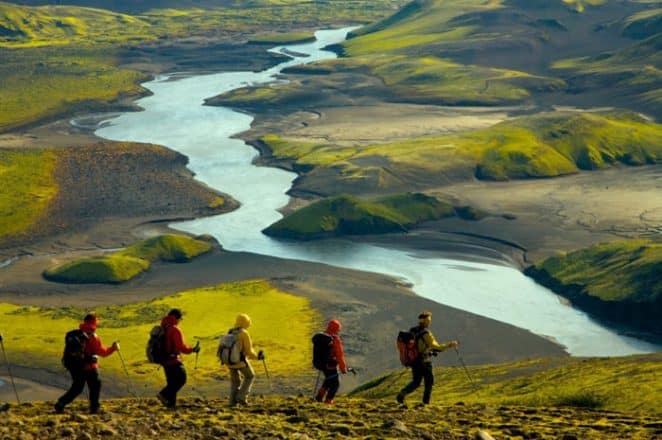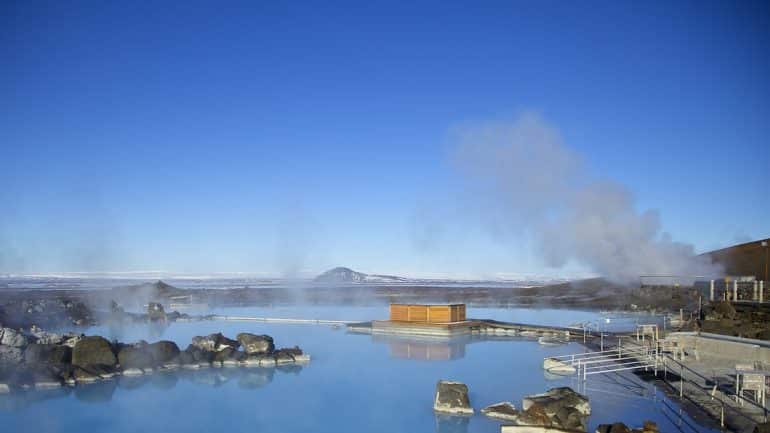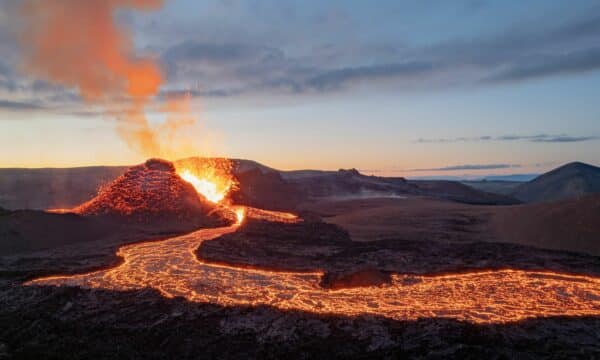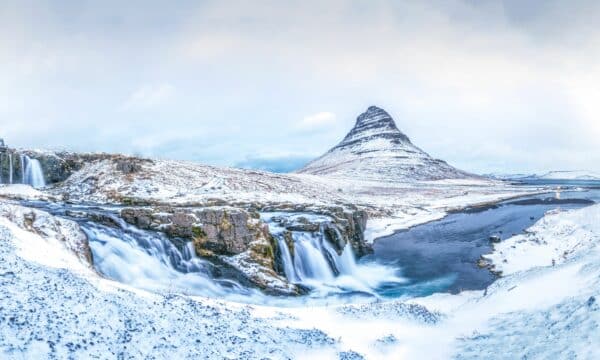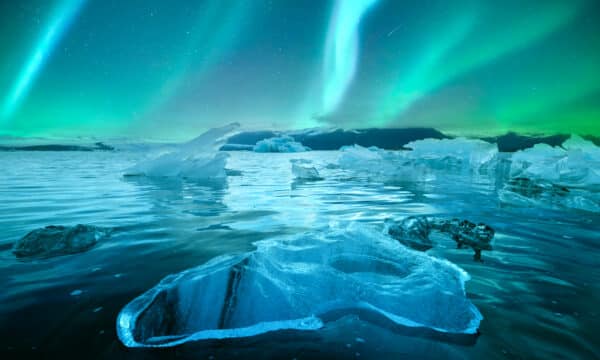- Header Photo: Wikimedia. CC. Hafsteinn Robertsson
In the depths of winter, Icelanders barely see any sunlight whatsoever, counting themselves lucky if they catch even a couple of hours of brightness a day.
The situation could not be more different in the warm and comforting summer months—May to August—when the sun remains shining boldly throughout the day and the night.
Given that fact, it takes little imagination to guess why this phenomenon has become known as the Midnight Sun.
- Make sure not to miss out on these amazing Summer Holiday Packages in Iceland
This omnipresent light is unique only to regions north of the Arctic Circle, or south of the Antarctic Circle.
This includes such countries as Finland, Greenland, Canada, Norway, Russia and the United States.
At the planet’s most extreme latitudes—the North and South poles specifically—the Midnight Sun is sometimes referred to as a ‘Polar Day’.
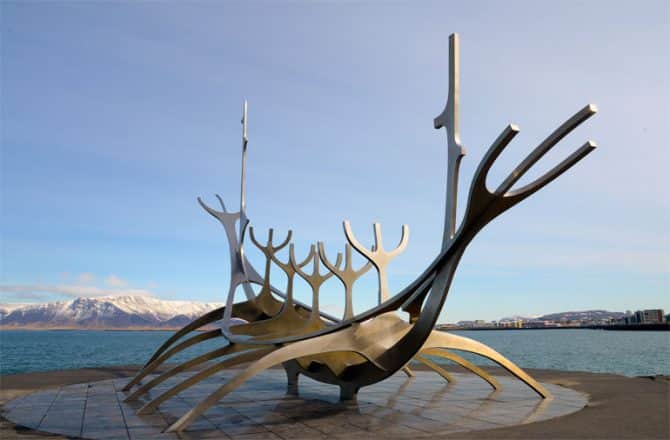
Iceland, however, has become synonymous with the Midnight Sun, as much for its intensity as the way it illuminates the fantastical landscapes beneath it.
If you’re planning on visiting Iceland during the summer, make sure to read on and learn more about this fascinating seasonal circumstance.
What Causes the Midnight Sun to occur?
The direct cause of the Midnight Sun is the axis of the Earth tilting towards our solar system’s sun during summer. It is this same tilt that causes seasonal changes across the planet.
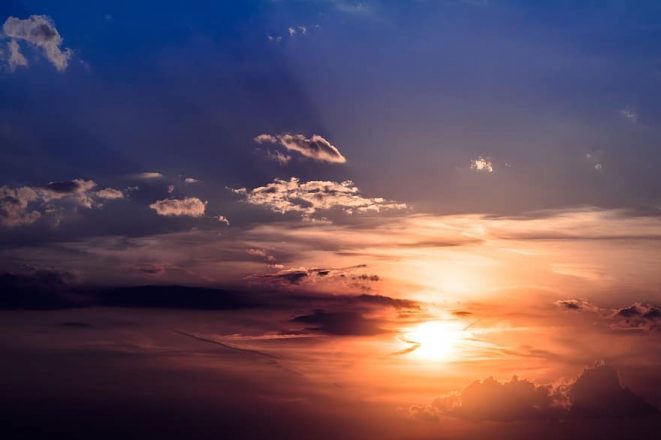
- Planning on visiting Iceland in the future? See this 10-Day Ring Road Road Trip | Self-Drive Tour of Golden Circle, South Iceland, Lake Myvatn & Snæfellsnes Peninsula
From July to September, the Northern Hemisphere experiences summer, while it is the opposite for the Southern Hemisphere.
Those regions closest to the Earth’s poles experience the most dramatic shifts in light. For most global citizens, this novelty is more than worth travelling for to experience firsthand.
Why does Iceland experience the Midnight Sun?
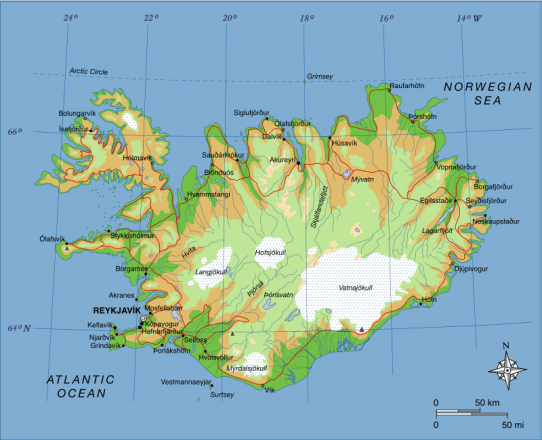
Mainland Iceland is located south of the Norwegian Sea, putting it just below the boundary lines of the Arctic Circle.
Given the extreme temperatures of such geography, only four million people are thought to live north of the Arctic Circle today. However, the area has been settled by various indigenous people for thousands of years.
The only Icelandic territory that can be indeed counted as lying within its limits is Grímsey Island, roughly 40 kilometres from the northern coast.
As a side note, visitors to Grímsey are obliged to stop at the Orbis et Globus, a 3-metre spherical artwork designed to be moved in accordance with the shifting Arctic Circle.
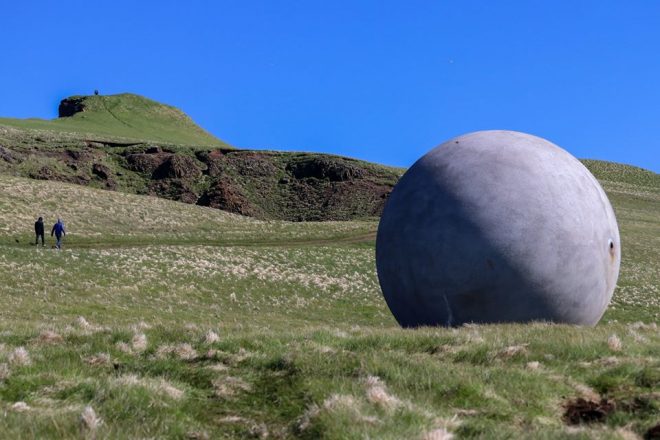
Grímsey island is home to little more than 100 permanent residents, but its location North of the Arctic Circle draws in thousands of visitors each summer.
Even so, the country of Iceland as a whole is close enough to the Arctic Circle’s border to experience the Midnight Sun each year.
To put it another way, Iceland’s capital city, Reykjavík, rests on a latitude of 64.1°N, while the Arctic Circle begins at 66.5°N.
- Travel the full expanse of the country on this 8-Day Summer Self Drive Tour Around the Ring Road – Golden Circle, Glacier Lagoon, Remote East Iceland & Akureyri
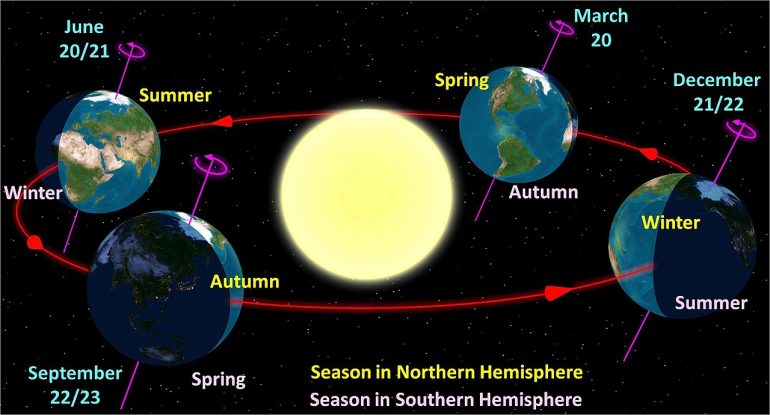
This tiny difference is the reason why the Midnight Sun is not shining at full strength in Iceland throughout the night, instead always leaving a few hours of dimming light.
This short period is known in science as ‘Civil Twilight’, though landscape photographers might better know it as ‘The Golden Hour’ due to the fortuitous lighting conditions that occur during this time.
When is the best time to see the Midnight Sun?
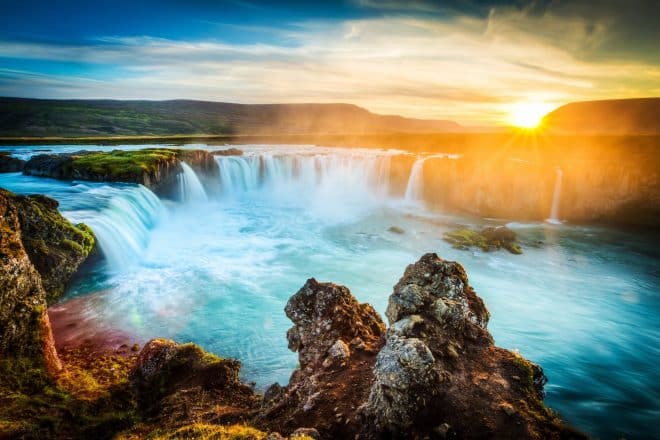
The Midnight Sun can be seen throughout summer in Iceland. It peaks around the 21st of June, right beside the summer solstice, which takes place only three days later.
From May to August, visitors can expect fully lit days, though the sun will dip below the horizon line just before midnight.
The very longest days of the year in Iceland occur in June and July, with the sun setting at 12:03 AM before rising once more around 2:55 AM.
The widely celebrated Summer Solstice—known in Icelandic as Sumarsólstöður—falls between the 20th and 22nd of June every year.
(Summer Solstice will take place on the 21st of June in 2021, 2022 and 2023. On the opposite end of the spectrum, Winter Solstice takes place between the 20th and 23rd December each year.)
Midnight Sun and the Summer Solstice in Icelandic Folklore
The Midnight Sun holds a compelling place in the lore and Sagas that have made Iceland famous the world over. Its Summer Solstice traditions are equally captivating, providing an insight into the fascinating history and culture of this isolated island nation.
When Iceland was initially settled, the first inhabitants—the infamous Vikings—were devotees of Norse mythology, having brought their beliefs over from Norway.

Early settlers believed that the Summer Solstice marked the moment that Baldur—God of Light, Purity and the Summer Sun—died after falling victim to a nasty plan by the trickster, Loki.
Named after John the Baptist, Jónsmessa (St. John’s Mass)—or Midsommer’s Night—takes place on the 24th of June in Iceland, in line with the country’s more recent adoption of Christian traditions.
One rather peculiar superstition of Jónsmessa—not commonly held nowadays, one might add—is that during elongated periods of sunshine, it is advised to roll around naked in the dewy grass to bring on a dose of good luck.
Feel free to try this strange behaviour if you’re feeling short of fortune during your trip (—and don’t mind the inquisitive look of passing strangers.)

Other bizarre happenings include seals transforming into humans, cows speaking fluent Icelandic, and healing stones revealing themselves on the surface of lakes and rivers.
It is also one of the four nights of the year when Iceland’s famous elves, the Huldufólk (‘Hidden Folk’), reveal themselves to passing travellers.
If, on the very off chance you happen to stumble across these supernatural entities during your summer jaunt in the land of ice and fire, be warned—Huldufólk are said to lure unknowing visitors into the wilderness with the promise of gifts and food.
Where can you see the Midnight Sun in Iceland?
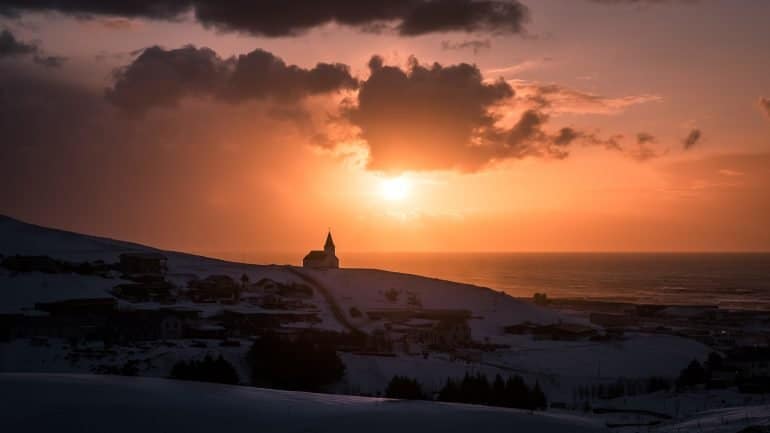
If you’re worried there’s a chance of missing out on seeing this celestial wonder during your visit—fear no more! The Midnight Sun can be seen throughout Iceland during the summer.
- Learn more about this exciting season in our article What is the First Day of Summer in Iceland All About?
Unlike Iceland’s other great cosmic attraction, the Northern Lights—which rely on clear skies and a lack of light pollution—there is no need to find an isolated area to enjoy this 24/7 illumination.
With such freedom at your disposal, it’s often beneficial to consider which sites you would like to see beneath the Midnight Sun before setting out.
Below, we have included a handful of incredible stops where the aesthetics of each is heightened dramatically when caught in the warm pink glow of the Midnight Sun.
Jökulsárlón Glacier Lagoon under the Midnight Sun
Jökulsárlón glacier lagoon has long been among Iceland’s most beautiful sights, boasting a crystal clear water-body dotted with resident seals and glistening icebergs.
Under the Midnight Sun, the glacial water reflects in a genuinely heavenly manner, creating an ethereal ambience that will forever cement South East Iceland in your heart.
Only few minutes walk from Jökulsárlón is Diamond Beach, another stunning vista that sees the lagoon’s icebergs wash up against a jet-black shoreline.
This creates a brilliant colour contrast, quickly lending itself to photographers hoping to capture phenomenal snaps.
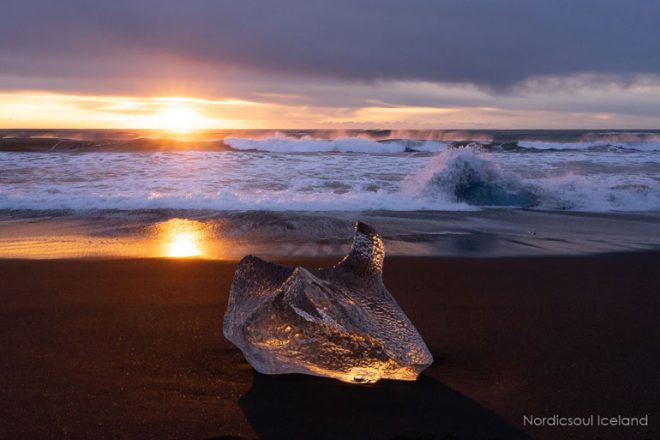
Of course, this is only touching upon Jökulsárlón’s beauty.
Located in Vatnajökull National Park, guests will find themselves surrounded by incredibly mountainous scenery, including luscious slopes in Skaftafell Nature Reserve—a favourite spot amongst hikers and cavers.
South Coast Waterfalls & the Midnight Sun
These two waterfalls are considered staple attractions in South Iceland and are included in the vast majority of sightseeing tours of the area.
Both waterfalls (foss in Icelandic) have become superstars in their own right thanks to their fairy-tale aesthetic and easy accessibility from Reykjavík. Seljalandsfoss and Skógafoss can both be seen from the Ring Road.
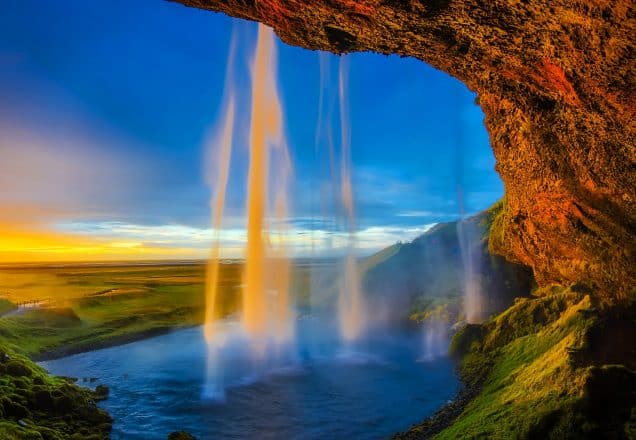
Seljalandsfoss (65 metres) is most famous for the cavernous footpath that leads behind the cascading water. Walking it opens up great photography opportunities, though you will likely get a little damp due to the ever-present moisture in the air.
A few minutes stroll from Seljalandsfoss, guests can also discover another falls, Gljúfrabúi, hidden inside one of the many crevasses of the South Coast’s ancient cliff sides.
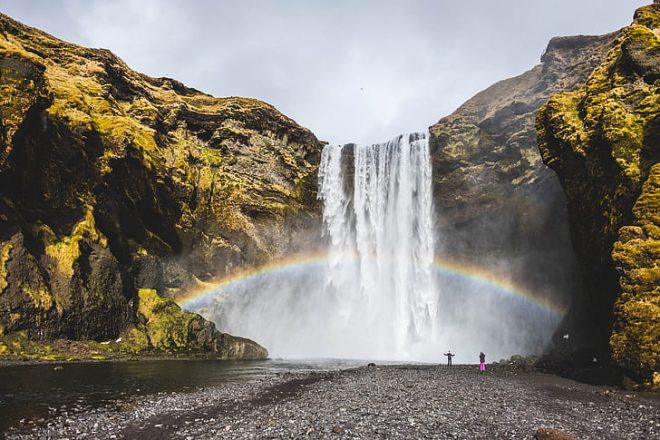
A mere 30 kilometres east of Seljalandsfoss, Skógafoss waterfall (62 metres) has its own magnificent draws. Legends promise hidden treasure, stowed away in a concealed cavern behind its powerful 25-metre wide curtain of water.
Skógafoss can be viewed from the bottom—just metres from where the water smashes into the Earth—or at the very top of a winding staircase that overlooks the whole feature.
Visiting the Golden Circle at Night
The national park of Þingvellir, Geysir geothermal area and Gullfoss Waterfall make up Iceland’s most popular sightseeing route, the Golden Circle.
Those looking to avoid the crowds should consider a nighttime trip to this trio of destinations. The Midnight Sun will provide enough light for you to enjoy the beauty of the Golden Circle to the fullest.
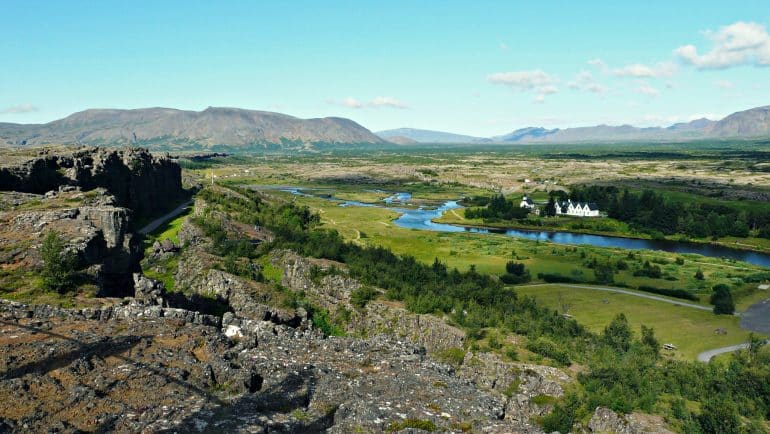
The UNESCO World Heritage site, Þingvellir, is made up of moss-laden volcanic field which lie between the Eurasian and North American tectonic plates, both of which stand exposed dramatically above ground.
Þingvellir (“Fields of Parliament”) is where one of the world’s oldest political gatherings, the Alþingi, was formed in 930 CE. It also happens to be where Iceland chose, en masse, to convert from Norse Paganism to Christianity in 1000 CE.
Summing it up, Þingvellir National Park is a crucially important location when it comes to Icelandic culture, geology and history.
- Looking to learn more? Read on in The Best Things to See and Do in Iceland’s Golden Circle – A Practical Guide to Iceland’s Most Popular Sightseeing Route
Geysir geothermal area is home of a multitude of bubbling mud pools, hissing fumaroles, and—most importantly—erupting geysers. It is here you’ll find the mighty hot spring, Strokkur, which erupts every 5-10 minuets in a spectacular display.
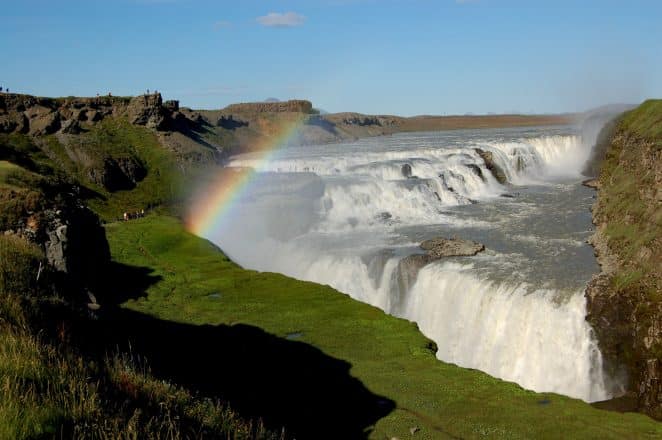
A short drive away from the Geysir area is the stunning Gullfoss Waterfall. Fed by Iceland’s second largest glacier, the river Hvítá rushes south from the Highlands before plunging into an ancient canyon, creating this beautiful cascade in the process.
All three sites make for fantastic choices to appreciate beneath the Midnight Sun.
Reykjavík, Capital Region
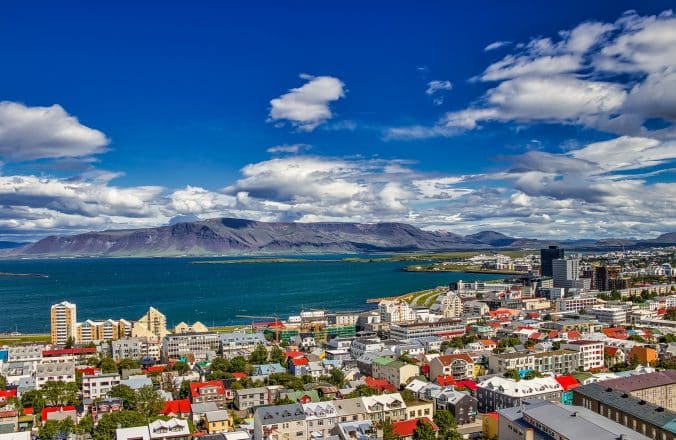
There are countless locations in and around Iceland’s capital city that can be thoroughly enjoyed beneath the Midnight Sun.
Reykjavík boasts plenty of bars with outdoor seating areas, with most staying open late into the night or longer during the summer. The city’s nightlife really kicks off during the summer, providing the perfect opportunity to meet up and socialise with locals and other visitors alike (However, COVID-19 has changed the scene temporarily).
There are also countless parks in which to sit and have a late-night picnic. The best of these include Hljómskálagarðurinn, beside the central Lake Tjörnin, and Klambratún, perfect for a late-night game of frisbee golf.
Other sites nearby to Reykjavík include the picturesque Grótta lighthouse, and the Rauðhólar (“red hills”) pseudo-craters in the Elliðaárhraun lava fields.
Mount Kirkjufell, Snaefellsnes Peninsula
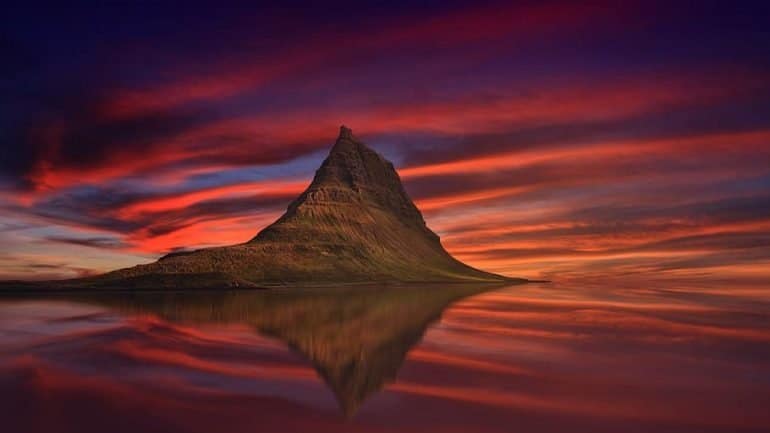
Made famous in HBO’s hit fantasy series, Game of Thrones, the “mountain like an arrowhead” Kirkjufell has become a pilgrimage of sorts for fans travelling in Iceland.
At 463 metres high, Kirkjufell is one of the country’s most iconic mountains. It dramatically overlooks the small fishing town of Grundarfjörður and is surrounded by impeccable black sand shorelines.
With that said, it is not so much a question of where to see the Midnight Sun, but how best to enjoy it?
What fun activities can you experience under the Midnight Sun in Iceland?
An excess of daylight hours leaves plenty of time to fit in activities you might not otherwise during your time in Iceland.
For instance, a late-night hike under the sunshine is sure to provide lasting memories, as is a relaxing end-day dip in a geothermal hot tub.
- Make sure to read 14 Best Things to See and Do in Iceland
Talking of hot tubs, there are several relaxing spas throughout the country that offer relaxation and healing. While most are open throughout the year, these establishments shine during the summer when guests can soak themselves beneath the Midnight Sun.
The most famous of these retreats is the Blue Lagoon Spa, located on the Reykjanes Peninsula between Reykjavík and Keflavík International Airport.
Other notable resorts include Krauma Spa in Reykholt village, Fontana at Lake Laugarvatn and the Mývatn Nature Baths in North Iceland.
Visiting spas is often included as part of excursion packages in Iceland. To make the most of this bright and cheery season, visitors to Iceland are always recommended to partake in a multi-day summer tour so as to maximise their holiday experience.
Not only will guests on a multi-day tour have the opportunity to explore each of Iceland’s beautiful region’s in-depth, but they will also undertake the country’s best activities under glowing sunlight.
- See our selection of Small Group Packages and Off The Beaten Path Packages
Many tours in Iceland specifically alter their business hours to accommodate visitors looking to maximise the Midnight Sun.
For example, whale watching tours, ATV and buggy rides, and even glacier hikes will often run late into the night so as to best showcase this island’s unique and exquisite nature.
The Secret Solstice Music Festival in Iceland
Die-hard music fans in Iceland spend the year looking forward to the brilliant Secret Solstice Festival, taking place in late June each year.
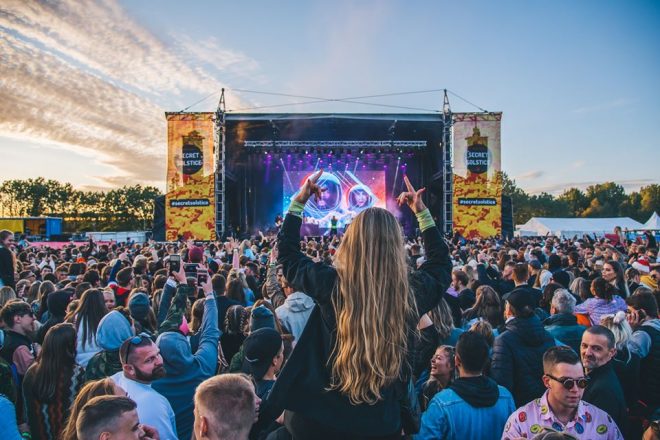
As a truly unique and unforgettable music experience, the festival was born from a desire to showcase both Icelandic and international talent, as well as the country’s distinctive nature.
Former venues have included the glassy interior of a glacial cave, a 5000-year old lava tunnel and even the auditorium-esque magma chamber of a dormant volcano.
Former acts have included giants of the industry, including the likes of Patti Smith, Robert Plant (of Led Zeppelin fame), The Sugarhill Gang, The Black Eyed Peas, Pussy Riot, Anderson Paak, Cypress Hill, Ministry of Sound, and Bonnie Tyler.
That’s not to mention the countless Icelandic acts that have graced the Secret Solstice stage. Though less widely known than their international counterparts, foreign guests have discovered such fantastic local musicians as the rap duo JóiPé and Króli, heavy-rockers like The Vintage Caravan, and more experimental, electronic performers like the band, Múm.
Is it hard to sleep with the Midnight Sun in Iceland?
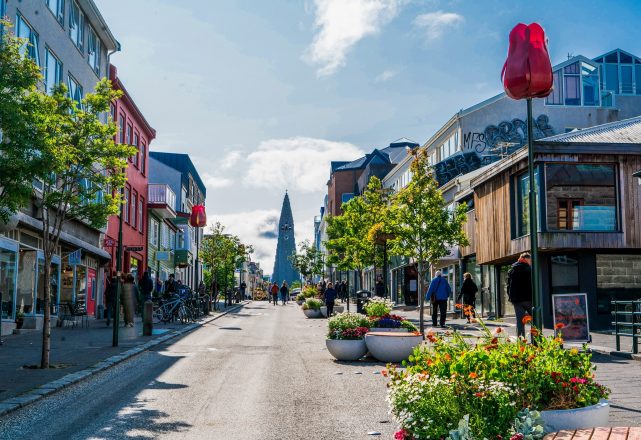
When it comes to moving into the season of the Midnight Sun, there is no doubt a dramatic shift in light can affect local residents’ sleeping patterns.
After all, it can be quite challenging to feel tired when the sun is still blazing outside in the late hours of the evening. The high levels of energy experienced can be, for lack of a better word… tiring.
This can be all the more difficult for visitors after a long plane journey when their body-clock has already been shifted uncomfortably out of balance.
One way that Icelanders deal with this issue is by putting up black-out curtains over their windows. This prevents any natural light from entering the bedroom, allowing them to more easily drift to sleep.
Of course, travellers don’t often come equipped with their own set of black-out curtains. In that case, a sleep-mask should be more than adequate for your nightly needs.
Another method is to limit the amount of exposed light one experiences the nearer they approach bedtime. Sometimes, the body requires darkness and silence for the mind to settle down into sleep.
How To Dress for the Midnight Sun in Iceland
Iceland’s name can be a touch confusing, drawing people into the illusion that the country is frozen throughout the entire year.
While it might be correct to describe Iceland as such during the winter, the summer is surprisingly temperate, with a pleasant climate not unlike other Western European nations.
Average temperatures during the summer in Iceland range from 10–13 °C (50–55 °F), though some days have been known to reach 20–25 °C (68–77 °F).
The highest temperature ever recorded—a positively sweltering 30.5 °C (86.9 °F)—was taken in the Eastfjords in 1939.
(Interestingly enough, East Iceland has long held a reputation as being the sunniest region in the country.
Though the east is rarely visited by tourists—in large part due to its distance from the capital— the promise of sunlight adds to the long list of reasons to explore the region, alongside other such draws as herds of wild reindeer and staggering, untouched nature.)
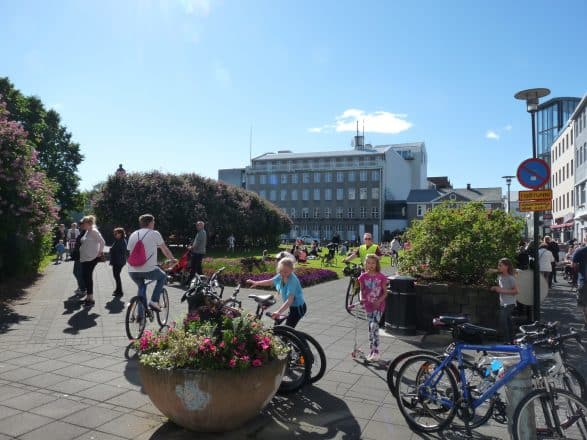
When it comes to dressing appropriately for the summer weather, travellers can often get away with such exotic attire as t-shirts and shorts.
With that said, the weather in Iceland is notoriously fickle, so it is always recommended to bring thick layers with you should the winds pick-up or the temperatures drop suddenly.
Final Thoughts About the Midnight Sun in Iceland
The Midnight Sun in Iceland is one of those rare experiences that requires no money, nor any prior preparation to enjoy in full.
Iceland is beautiful enough, regardless of whether one visits in the summer or winter. Still, the Midnight Sun undeniably casts this island in an entirely new light—both figuratively and literally—and should be most certainly sought out by travellers weighing up their options.
This sentiment is especially true for those who have yet to experience this phenomenon, whether it be in Iceland or anywhere else.
The majesty of this country’s landscape, when illuminated beneath this otherworldly luminescence, can hardly be described in words—at least, not by someone like me, who to this day remains breathtakingly in awe of the summer months.
And so, it’s probably best to leave you, dear reader, with a passage penned by Halldór Laxness, Iceland’s most beloved author.
‘“Think of me when you are in glorious sunshine.” Soon the sun of the day of resurrection will shine on the bright paths where she awaits her poet. And beauty shall reign alone.’

